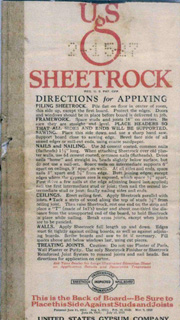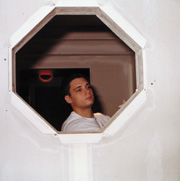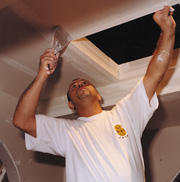

A picture posted on the W&C message board recently got us thinking about our industry, and if it has kept pace with the rest of the world. Contributor Mike Gill was tearing out some drywall when he found one of those "buried treasures" that come along occasionally. The USG label dates Feb. 15, 1927.
We thought we'd recover some news of the day to give you a taste of how different things are.

Back in time
In 1927 if you cut yourself and chose to cover the wound with a Band-Aid brand bandage, you had to cut off as much as needed from the 3-inch-by-18-inch bandage.When commercial telephone service was offered between New York City and London, the first three minutes of the call cost $75.
Walls & Ceilings magazine would not be published for another 11 years.
Augustine Sackett's cardboard-backed wallboard patent of 1894 was already 33 years old.
The cost of a Broadway ticket in 1927 was $4.50.
Calvin Coolidge was president and, to the best of our knowledge, all he ever did with cigars was smoke them.
The concealed-lace basketball was introduced in this year. Before, the concealed-lace ball bounced at unexpected angles when the lacing hit the floor.
The first person to be selected as the Time magazine "Man of the Year" was Charles Lindbergh for the first solo flight across the Atlantic Ocean.
Babe Ruth hit a record 60 home runs. That has since been broken, but with the changes in balls, bats, training regimens and the schedule, some would argue that still stands.
Baseball was America's pastime.
The average family made less than $1,000 per year.
The Cecil B. DeMille epic movie "King of Kings" opened in 1927. The two stars cast as Jesus and Mary were required to sign agreements prohibiting them from appearing in film roles that might compromise their "holy" screen images for five years. DeMille also forbade them to be seen doing any "unholy" activities during the film's shooting. These activities included attending ball games, playing cards, swimming, going to nightclubs and riding in convertibles.
Felix the Cat was the character of the first big balloon to fly in the Macy's Thanksgiving Day parade. At the end of the parade the balloons were released. They would float for days and prizes were given to the lucky finders.
If you chose to install drywall in your new house, you were a pioneer.
Look at some of the drywall installation directions from 1927 compared with today's methods:
Sawing: Place this side down and use a sharp handsaw. Bevel face side of all sawed edges or mill cut ends, using coarse sandpaper.
We are sure you will agree that the availability of utility knives and rasps is a welcome advance. The tool pouch design alone that would enable a rocker to carry a hand saw on his hip would be daunting to say the least.
Nails: 3d cement-coated common nails.
Enough said. We are glad to report the use of sharp-point, cement-coated drywall nails. Drywall screws are being used almost exclusively. There are those little pockets around the country where you will still see blue ring shanks or 1 1/2-inch roofing nails being used. Typically, these are places where there is still party-line phone service, the car of choice is the Rambler, and the outhouse needs a once-a-month cleaning.

The changes are inevitable
Other than the recommendation of hanging the ceiling parallel with the joists and the walls' being stood up, the rest of the directions have remained unchanged. If you consider that almost every other material used in construction has changed or evolved, drywall has remained much the same. It is still, simply stated, a paper and gypsum sandwich. Is that because the technology has finished evolving; that it's beyond any possible improvement? Or have we as an industry become truncated, with 5 p.m. visionary foresight? Granted, there have been significant advances in the manufacture of drywall, but it's still fundamentally unchanged since its inception. What about other construction materials?Consider the basement. This primary element of construction has gone from stone, to block and poured concrete. Now there are Superior Walls with framing in place and a watertight guarantee. Styrofoam and poured concrete are also being used as energy efficient components of a basement system.
Framing is another area where one can find considerable improvement. Wood I-beams and the use of glue lamination have made it possible to span previously unheard of lengths. Along with incredible strength comes consistent dimensions and arrow-straight lumber. Making this material even better is the fact many of the components being used would have been burned or thrown away not too many years ago. The fact that more steel is being used also saves more of our precious trees.
The firetrap electrical wires snaking their way through attics are a thing of the past. The replacement of this "rodent floss" has been a boon to fire companies everywhere.
Siding has seen its share of controversy. From the boiler room aluminum siding salesman, to the media-hyped North Carolina witch-hunt, the fact remains there are more choices for siding your house than ever.
We can go on and on, but you get the point. As always, we invite ideas and criticism, and we especially encourage new and would-be inventors to come forward with their ideas and let us help you expose them. The best things in the trade are usually developed by tradesmen themselves, and we're continually amazed at how many good ideas there are that never get off the ground.
After all it's drywall. For some it's a way to break their back. For others, it's an opportunity for invention.
As promised from last months' piece, these are the winners of the UIPAT winners. Sheetrock on, gentlemen!
